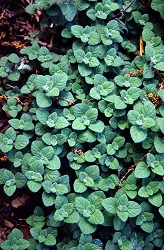Growing Origanum species -Marjorams and Oreganos
 The genus Origanum is known both as marjoram and oregano. It includes around 20 species and belongs to the same plant family as mint, thyme and rosemary. All of these plants have oil glands in the leaves. Plants in this family include many different common and less common herbs.
The genus Origanum is known both as marjoram and oregano. It includes around 20 species and belongs to the same plant family as mint, thyme and rosemary. All of these plants have oil glands in the leaves. Plants in this family include many different common and less common herbs.
A semi-hardy perennial to 35 cm tall, with grey-green foliage, and white or pink flowers. The closely related oregano is O. vulgare 'Viride'. It grows to 0.6 m tall, and has pale to white-green, slightly hairy leaves.
:
Growing Conditions
Prefers a warm sunny position, with full or filtered sun. Frost sensitive. Grows in both cold and warm climates.
Culture:
Grows best in a well-drained, fertile, weed free soil. Fertilise every two to three months with compost, manure or liquid fertiliser. Maintain a high pH by adding lime or dolomite once a year. Do not over-water. Responds to moderate pruning after flowering.
Companion Planting:
Companion plant with beans. Oregano is good companion for cabbages and cucurbits.
Propagation:
By seed, cuttings, division or layering. Division of larger plants is the easiest method, although taking soft to semi-hardwood cuttings in spring or autumn is usually successful to produce a larger number of plants.
Pests and Diseases:
Few. Aphids and white fly are sometimes a problem.
Uses:
Culinary use, particularly for adding flavour to meats, pasta and vegetables, both as fresh or dried leaves. Can also be used in a gargle (tea) and as an antiseptic. Oregano leaves can be used fresh or dried, and the flowers can produce a reddish-brown to purple dye that is not very durable. Oregano should be pruned before flowering to maintain shape.
Cultivars
Origanum Marjorana (Sweet Marjoram)
A warm weather plant, to 30cm tall, yellow to grey green leaves, tiny white flowers, sweeter flavour than other origanums. Popular culinary herb. In cold climates, often grown from seed, sown early spring, as an annual.
Origanum Onites (Pot Marjoram)
A shrub to 0.5m tall with finer more wiry stems than other Origanums, pale green leaves and pink flowers.
Origanum vulgare "Aureum" (Golden Marjoram)
A clump forming plant to 0.4m tall with creeping (suckering) stems, golden green foliage and pink flowers.
Origanum vulgare (Wild Marjoram)
A semi hardy perennial to 0.2m tall. Grows best in a warm, sunny position in well drained fertile soil. Frost tender. Propagated by seed or cuttings.
Leaves are used fresh or dried in savoury dishes (particularly pasta, meats & vegetables). Closely related to oregano.
Origanum vulgare "Viride" (Oregano)
Stronger flavour or scent in the foliage, white flowers, to 0.6m tall, leaves a pale to white green colour and slightly hairy.
Oregano leaves can be eaten fresh or dried and the flowers can produce a reddish brown to purple dye that is not very durable. They should be pruned before flowering to keep in shape and can be propagated by seed, cuttings or root division.
You may also be interested in....